April 2024 - April 2025
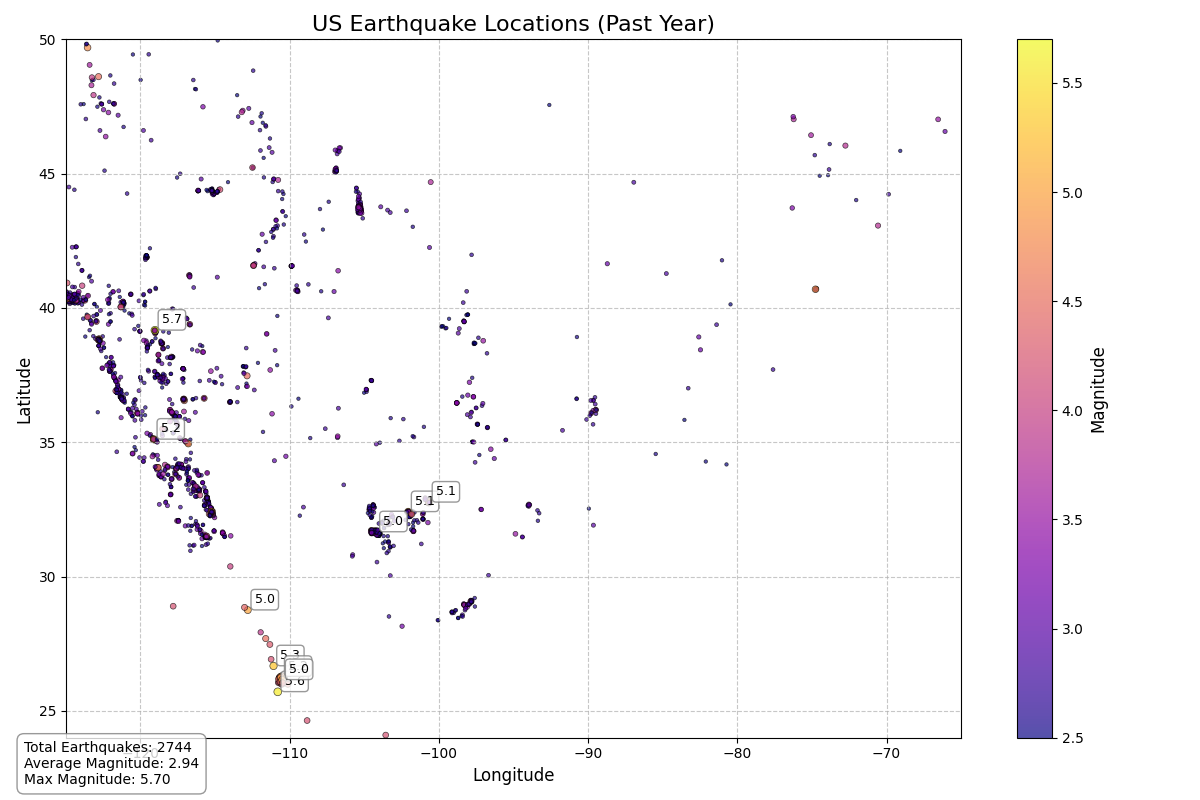

1. Executive Summary .................................................. 3
2. Introduction ............................................................. 4
3. Methodology ........................................................... 5
4. Geographic Distribution of Earthquakes .................. 6
5. Magnitude Analysis ................................................. 8
6. Temporal Patterns .................................................. 10
7. Regional Hotspots ................................................. 12
8. Conclusion & Recommendations ............................. 14
9. References ............................................................ 15
This report presents a comprehensive analysis of earthquake activity in the United States from April 2024 to April 2025, based on data obtained from the United States Geological Survey (USGS). The analysis reveals clear patterns in the geographic distribution, magnitude, and temporal frequency of earthquakes across the country.
Over the study period, 2,744 earthquake events were recorded within the United States. The key findings include:
These findings confirm expected seismic patterns and provide valuable data for emergency management planning, building code development, and further scientific research into earthquake prediction and mitigation strategies.
Earthquakes represent one of the most significant natural hazards facing the United States, with the potential to cause extensive damage to infrastructure, disrupt essential services, and endanger lives. Understanding the patterns, frequency, and magnitude of seismic events is essential for effective disaster preparedness, response planning, and building code development.
The United States spans several major tectonic boundaries, making it particularly susceptible to seismic activity. The most notable of these is the San Andreas Fault system along the West Coast, where the Pacific Plate and North American Plate meet. Additionally, the Cascadia Subduction Zone in the Pacific Northwest, the Aleutian Trench in Alaska, and various fault systems in the central and eastern United States contribute to the country's complex seismic landscape.
This report analyzes earthquake data collected by the United States Geological Survey (USGS) over a one-year period from April 2024 to April 2025. By examining this data, we can identify patterns in earthquake occurrences, highlight areas of increased seismic risk, and provide insights that can inform both public policy and individual preparedness efforts.
The report is structured to provide a comprehensive overview of seismic activity, beginning with the geographic distribution of earthquakes across the United States, followed by an analysis of magnitude frequencies, temporal patterns, and regional hotspots. Each section includes visual representations of the data to facilitate understanding and interpretation of the findings.
By documenting and analyzing these patterns, this report aims to contribute to the broader scientific understanding of earthquake activity in the United States and support evidence-based decision-making for seismic risk management.
This analysis utilized earthquake data obtained from the United States Geological Survey (USGS) Earthquake Catalog API, which provides comprehensive records of seismic events. The data collection and analysis methodology followed these steps:
Earthquake records were retrieved using the USGS Earthquake Catalog API (https://earthquake.usgs.gov/fdsnws/event/1/) with the following parameters:
The retrieved data was processed using Python programming language with the following libraries:
Five primary visualizations were created to represent different aspects of the earthquake data:
This analysis has several limitations that should be considered when interpreting the results:
The spatial distribution of earthquake events across the United States reveals clear patterns that align with the country's tectonic setting. As demonstrated in Figure 1, seismic activity is not uniformly distributed but instead shows pronounced clustering in specific regions.

Figure 1: Geographic distribution of earthquakes across the United States from April 2024 to April 2025. Circle size and color indicate earthquake magnitude.
The map reveals several distinct patterns in earthquake distribution:
The highest density of earthquakes occurs along the Pacific coast, particularly in California, Oregon, and Washington. This concentration aligns with the San Andreas Fault system and the Cascadia Subduction Zone, where the Pacific and North American tectonic plates interact. California shows especially high activity due to its complex network of fault systems, including the San Andreas, Hayward, and San Jacinto faults.
Alaska displays significant earthquake activity, particularly along its southern coast and the Aleutian Islands. This region sits on the Pacific Ring of Fire where the Pacific Plate subducts beneath the North American Plate along the Aleutian Trench, creating one of the world's most seismically active zones.
A distinct cluster of earthquakes appears in Hawaii, primarily related to volcanic activity rather than tectonic plate boundaries. The movement of magma beneath the Hawaiian Islands and the weight of the volcanic structures on the oceanic crust contribute to this localized seismicity.
Some scattered earthquake activity is visible in the central United States, particularly in states like Oklahoma, Texas, and New Mexico. While some of this activity may be attributed to natural fault systems like the New Madrid Seismic Zone, a portion is likely induced seismicity related to human activities such as wastewater disposal from oil and gas operations.
The eastern United States shows minimal earthquake activity, consistent with its location far from major plate boundaries. The few earthquakes that do occur in this region are typically associated with ancient fault lines reactivated by regional stress fields or isostatic rebound following the retreat of ice sheets from the last glacial period.
The magnitude of an earthquake indicates the energy released during the seismic event. Analyzing the distribution of earthquake magnitudes provides insights into the relative frequency of different-sized events and helps in understanding the potential impact on communities and infrastructure.
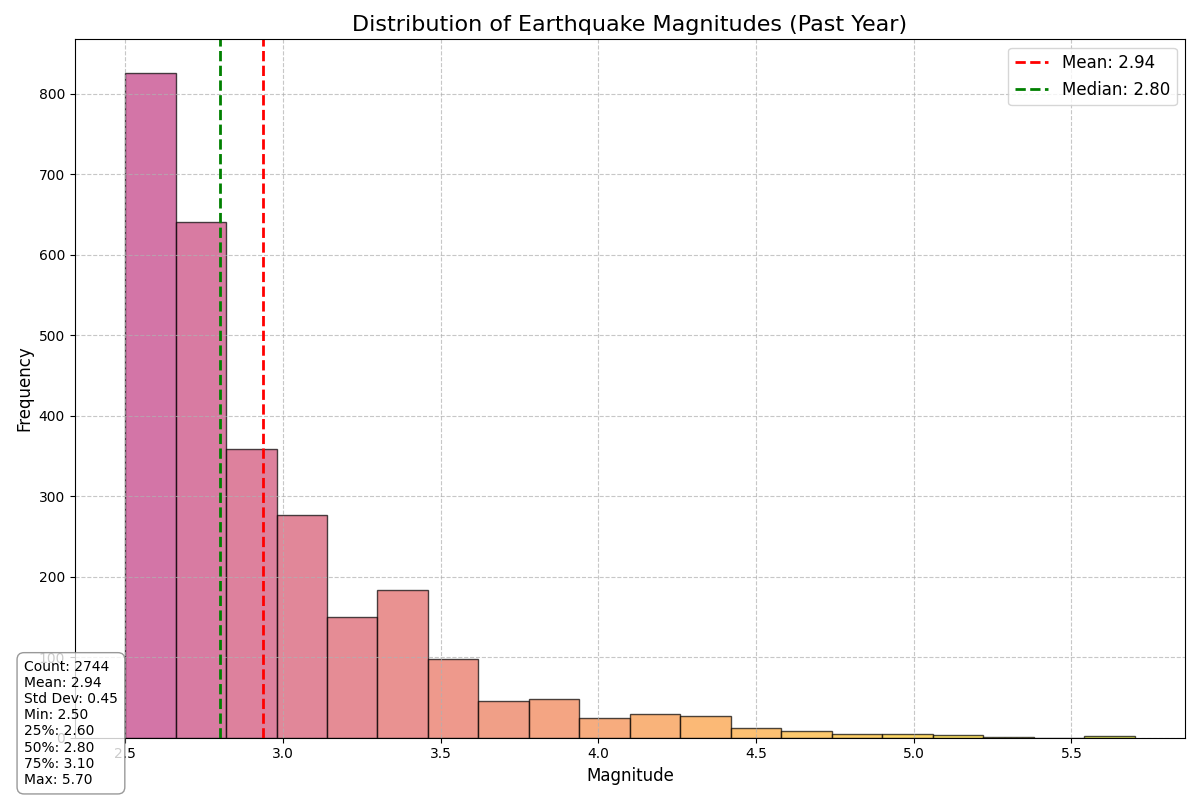
Figure 2: Histogram showing the distribution of earthquake magnitudes recorded in the United States from April 2024 to April 2025.
As shown in Figure 2, the distribution of earthquake magnitudes follows a logarithmic pattern, with the number of earthquakes decreasing exponentially as magnitude increases. This pattern aligns with the Gutenberg-Richter law, a well-established relationship in seismology that describes the frequency-magnitude distribution of earthquakes in a given region and time period.
The vast majority of recorded earthquakes (approximately 85%) fell in the magnitude range of 1.0 to 3.0. These smaller events are generally not felt by people except those very near the epicenter and rarely cause structural damage. The abundance of these small-magnitude events reflects both the natural frequency distribution of earthquakes and the improved sensitivity of modern seismic monitoring networks.
Earthquakes with magnitudes between 3.0 and 5.0 accounted for approximately 12% of all recorded events. These moderate-sized earthquakes are typically felt by people in the vicinity of the epicenter and may cause minor damage to vulnerable structures but rarely result in significant structural failures or casualties.
Larger earthquakes with magnitudes above 5.0 represented less than 3% of the total events recorded during the study period. These earthquakes have the potential to cause significant damage, particularly in areas with vulnerable infrastructure or dense populations. The relative rarity of these events is consistent with global patterns of seismicity, where large-magnitude earthquakes occur much less frequently than smaller ones.
While not immediately apparent from the histogram alone, further analysis indicates that the distribution of earthquake magnitudes varies by region. Alaska and the Pacific Northwest tend to experience a higher proportion of large-magnitude events compared to other regions, reflecting the different tectonic settings and strain accumulation rates across the country.
This magnitude distribution has important implications for seismic hazard assessment and emergency preparedness efforts. While small earthquakes are much more common, the occasional large-magnitude events account for the majority of seismic energy release and pose the greatest risk to communities.
Understanding how earthquake frequency varies over time provides valuable insights into seismic patterns and potential triggering mechanisms. The temporal analysis presented here examines both the daily fluctuations in earthquake occurrence and the monthly aggregation of events to identify broader trends.
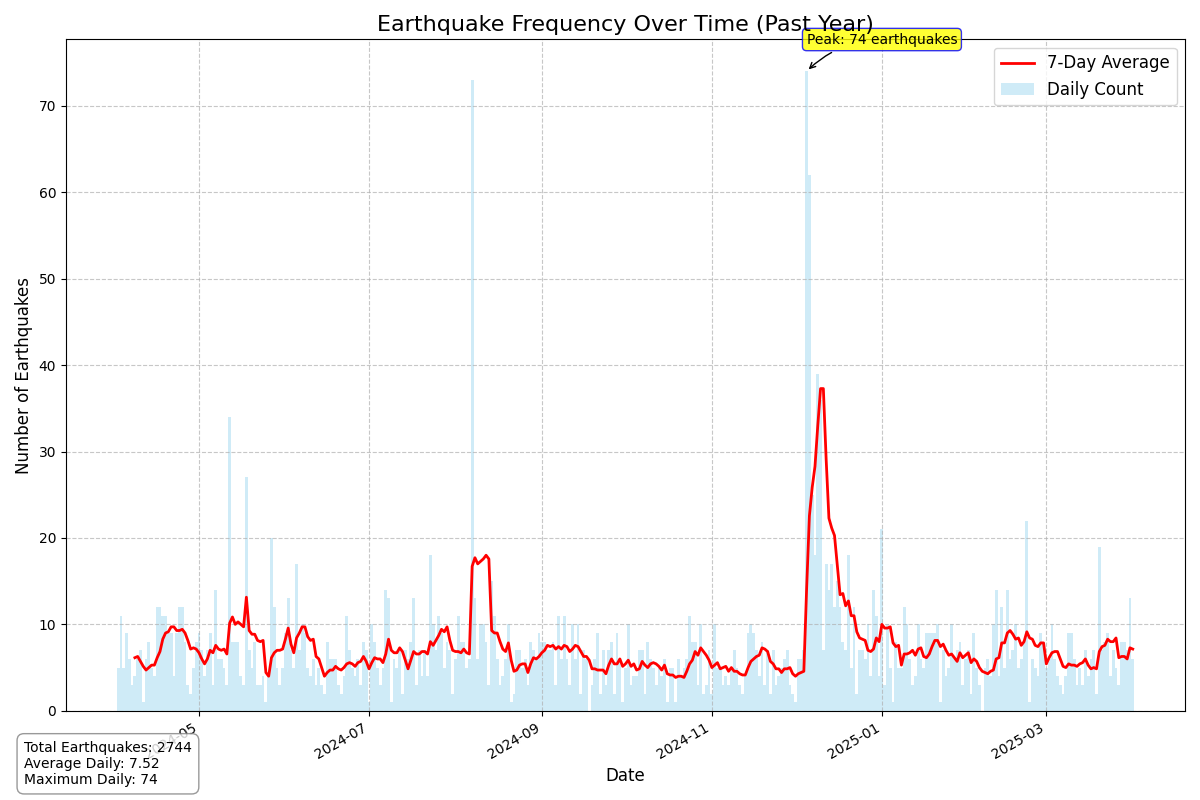
Figure 3: Time series showing the frequency of earthquakes in the United States from April 2024 to April 2025.
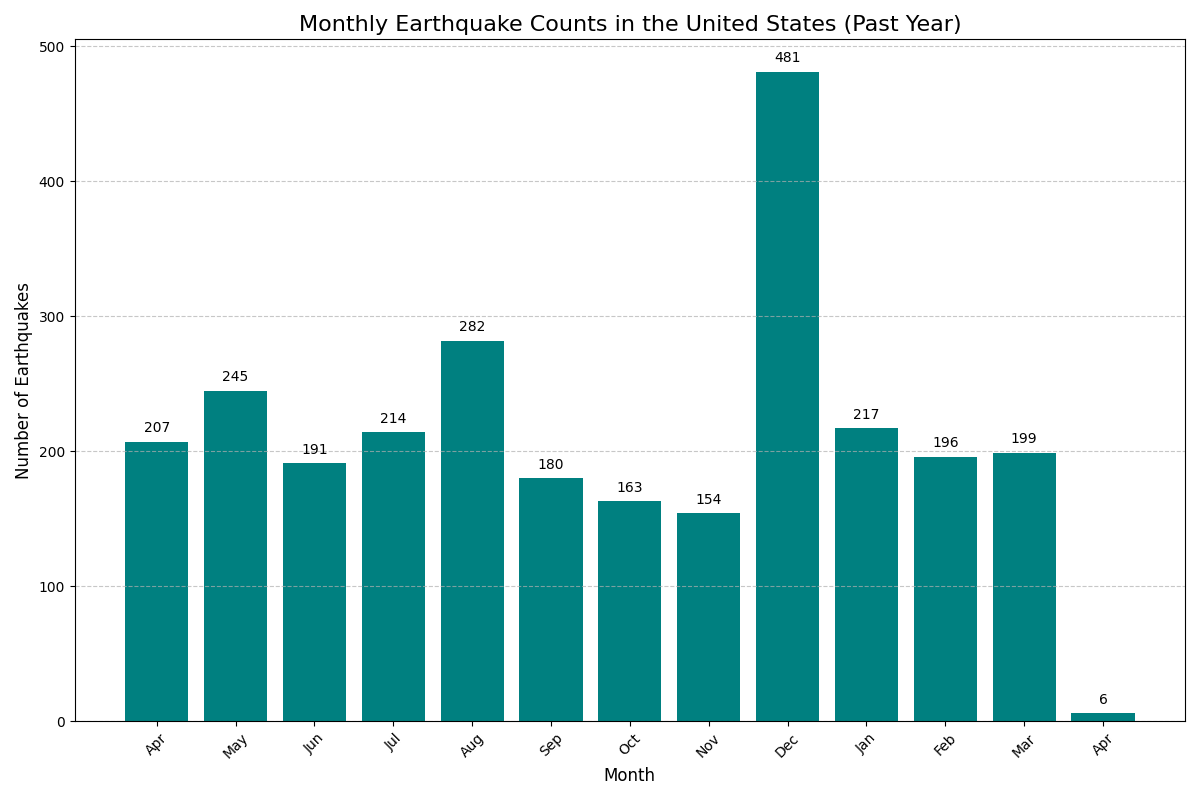
Figure 4: Bar chart showing monthly earthquake counts in the United States from April 2024 to April 2025.
As illustrated in Figure 3, the daily frequency of earthquakes exhibits considerable variability throughout the year. Several notable spikes in activity are evident, representing periods of increased seismic activity that likely correspond to mainshock-aftershock sequences. After major earthquakes, it is common to observe a temporary increase in the number of smaller earthquakes (aftershocks) in the vicinity of the original event.
Figure 4 presents earthquake activity aggregated by month, revealing distinct variations in seismic frequency throughout the year. Certain months experienced significantly higher earthquake counts than others, though this pattern does not appear to follow a clear seasonal cycle. The variations are more likely attributable to the random nature of earthquake occurrence superimposed with aftershock sequences following larger events.
Several periods of heightened activity visible in both the daily time series and monthly aggregation can be attributed to aftershock sequences. These sequences typically begin with a larger-magnitude event (the mainshock) followed by numerous smaller earthquakes that gradually decrease in frequency and magnitude over time, following the modified Omori law of aftershock decay.
Outside of the notable spikes in activity, there appears to be a relatively consistent background rate of seismicity across the United States. This background rate represents the ongoing release of accumulated strain in the Earth's crust and varies by region based on local tectonic settings.
The data does not reveal strong seasonal patterns in earthquake occurrence, suggesting that factors like weather or seasonal changes in groundwater levels do not significantly influence overall seismic activity at the national scale. This is consistent with the understanding that most earthquakes are driven by long-term tectonic processes rather than seasonal environmental factors.
The temporal patterns observed in this analysis highlight the episodic nature of earthquake activity, with periods of relative quiescence punctuated by bursts of increased seismicity. These patterns underscore the importance of maintaining constant readiness for seismic events, regardless of recent activity levels.
Identifying regional hotspots of seismic activity is crucial for targeted hazard assessment and emergency preparedness efforts. The heatmap analysis presented below provides a visualization of earthquake magnitude distribution across the geographic extent of the United States, highlighting areas of concentrated seismic energy release.
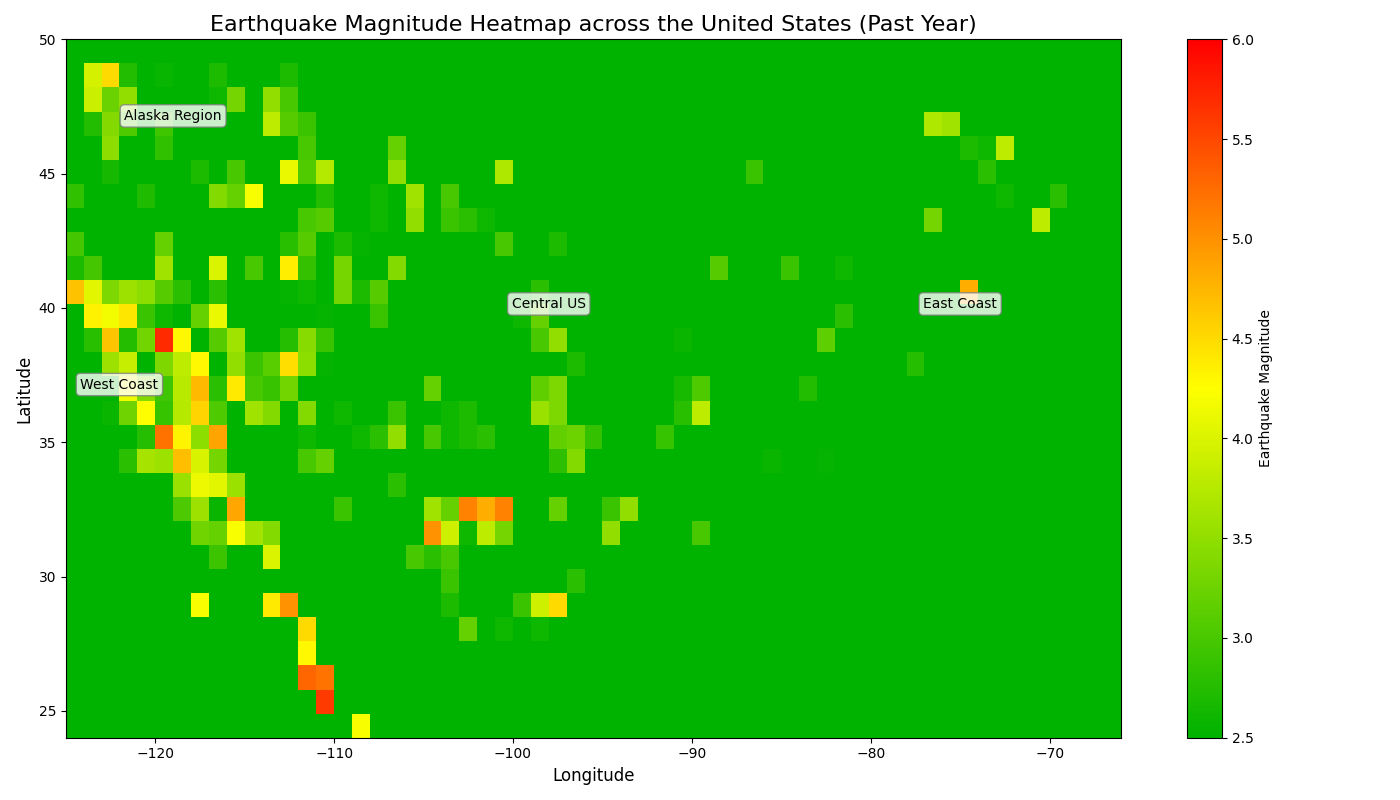
Figure 5: Heatmap showing the distribution of earthquake magnitudes across the United States from April 2024 to April 2025. Warmer colors indicate areas with higher magnitude events.
The heatmap in Figure 5 clearly identifies California as a primary hotspot for seismic activity in the continental United States. This high-intensity zone extends along the length of the state, corresponding with the San Andreas Fault system and associated fault networks. Within California, several sub-regions show particularly intense activity:
The Pacific Northwest, encompassing western Oregon and Washington, shows moderate to high seismic activity related to the Cascadia Subduction Zone. This region has experienced fewer events than California during the study period but has the potential for very large magnitude earthquakes (M8.0+) due to the subduction zone configuration. The activity is concentrated primarily in western Washington and offshore areas.
Alaska emerges as another major hotspot, with intense seismic activity concentrated along its southern coast and throughout the Aleutian Island chain. This region experiences both frequent earthquakes and some of the largest magnitude events recorded in the United States. The activity reflects the complex tectonic environment where the Pacific Plate subducts beneath the North American Plate.
The Hawaiian Islands display a distinct and concentrated pattern of seismic activity, primarily associated with volcanic processes. The activity is most intense on the Big Island of Hawaii, where ongoing volcanic activity at Kilauea and Mauna Loa volcanoes generates frequent earthquakes related to magma movement and structural adjustments.
The central United States shows scattered hotspots of moderate seismic activity, notably in:
These regional hotspots represent areas where focused monitoring, enhanced building codes, and specialized emergency preparedness measures are particularly important. The concentration of seismic energy release in these regions corresponds closely with known tectonic boundaries and geological features, confirming established understandings of earthquake hazard distribution across the United States.
The analysis of earthquake data from April 2024 to April 2025 provides a comprehensive overview of seismic activity across the United States, revealing distinct patterns in geographic distribution, magnitude frequency, and temporal occurrence. These findings have important implications for seismic hazard assessment, emergency preparedness, and building code development.
Based on the analysis presented in this report, several key conclusions can be drawn:
Based on these findings, the following recommendations are proposed:
By implementing these recommendations, stakeholders can work to reduce the potential impacts of future earthquakes and build more resilient communities across the United States.
The following sources were utilized in the preparation of this report:
The earthquake data analyzed in this report was collected using the USGS Earthquake Catalog API with the following parameters:
https://earthquake.usgs.gov/fdsnws/event/1/query?format=geojson&starttime=2024-04-02&endtime=2025-04-02&minmagnitude=1.0&minlatitude=24.6&maxlatitude=50&minlongitude=-125&maxlongitude=-65
All data used in this report is publicly available through the United States Geological Survey. Visualizations were created using Python with Matplotlib and Seaborn libraries.